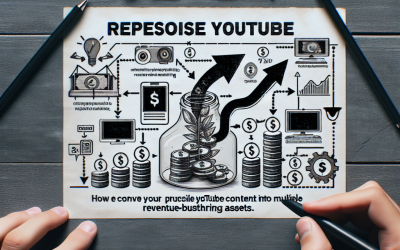Mastering YouTube Video Tags Best Practices to Boost Visibility and Drive Organic Growth
Understanding the Importance of YouTube Video Tags
In my experience with youtube video tags best practices, I’ve discovered that tags are often overlooked but incredibly powerful for boosting my video’s visibility. When I first started uploading videos, I underestimated how much proper tagging could influence discoverability. It wasn’t until I delved deeper into youtube video tags best practices that I realized their true potential.
From what I’ve learned, youtube video tags best practices are a key component of YouTube SEO. They help the platform understand your content and connect it with viewers searching for similar topics. In my experience, applying the right tags has significantly increased my organic reach and engagement, making it clear that mastering youtube video tags best practices is essential for growth. I want to share what I’ve learned so that you can also harness this powerful strategy to boost your channel’s visibility.
Top YouTube Video Tags Best Practices I Swear By
1. Be Specific and Relevant with Your Tags
In my journey, I’ve found that specificity is crucial when selecting youtube video tags best practices. I always aim to include tags that accurately describe my content. For example, instead of just tagging “gaming,” I add more precise tags like “Fortnite gameplay tips” or “best gaming headset 2024.” This helps my videos reach viewers searching for exactly what I offer.
I recommend doing thorough research to find the most relevant tags for your niche. From my experience, highly relevant tags improve your chances of appearing in search results and recommended videos. I also use a mix of broad and long-tail tags to maximize reach while maintaining relevance. youtube video tags best practices emphasize relevance, and I believe this is a foundational rule I always follow.
2. Use a Mix of Popular and Niche Tags
From my research, balancing popular tags with niche-specific ones can make a huge difference. Popular tags help you tap into high-traffic searches, but they’re highly competitive. Niche tags, on the other hand, target a specific audience that’s more likely to engage with my content. I’ve found that combining both has helped me grow my channel faster.
For instance, I might include trending tags like “Vegan recipes” alongside more targeted tags like “Vegan gluten-free breakfast ideas.” This approach aligns perfectly with youtube video tags best practices. It’s a strategy I highly recommend because it allows your videos to rank for both broad and specific searches, increasing your overall visibility.
3. Keep Tags Organized and Consistent
In my experience, consistency in tagging across videos helps build a recognizable brand and improves my SEO. I’ve developed a habit of creating a core set of tags related to my main topics and including them in every video. This consistency sends positive signals to YouTube’s algorithm about my channel’s niche.
Additionally, I recommend updating your tag strategy periodically. I’ve learned that reviewing which tags perform best and refining them over time ensures that your tags stay relevant and effective. Proper organization and consistency are youtube video tags best practices I follow religiously for sustained growth.
How to Choose Effective YouTube Video Tags
1. Conduct Keyword Research for Your Tags
My first step in selecting youtube video tags best practices is thorough keyword research. I use tools like TubeBuddy or VidIQ to identify high-volume and relevant keywords. These tools help me discover trending tags and long-tail keywords I might not have thought of.
From what I’ve learned, incorporating these researched keywords into my tags boosts the chances of my videos appearing in search results and suggested videos. I recommend dedicating time to this process because well-researched tags are the backbone of effective SEO. In my experience, a strategic approach to keyword research is one of the most impactful youtube video tags best practices.
2. Use Descriptive and Accurate Tags
In my own experience, I’ve discovered that honesty and accuracy in my tags prevent misleading viewers and help retain my audience. I avoid stuffing irrelevant keywords just to get more views. Instead, I focus on tags that truly reflect my content.
I recommend thinking about what your target audience might search for and including those terms. When I do this, I notice my videos attract viewers genuinely interested in my niche. Adhering to youtube video tags best practices by being honest with my tags has helped me build trust and credibility with my viewers.
3. Limit the Number of Tags
From my research, I’ve found that overloading my videos with dozens of tags doesn’t necessarily improve rankings. YouTube’s algorithm favors quality over quantity. I usually stick to around 10-15 highly relevant tags that cover my main topics.
I’ve learned that focusing on quality tags that truly describe my video content is more effective than trying to game the system with spammy tags. This approach aligns with youtube video tags best practices and has helped me maintain a clean, professional channel.
Common Mistakes and How to Avoid Them
1. Using Irrelevant or Clickbait Tags
In my experience, one of the biggest mistakes I see new creators make is using clickbait or irrelevant tags. It might seem tempting to attract clicks, but I’ve found that this backfires. When my tags don’t match my content, my audience gets disappointed, and my engagement drops.
To avoid this, I always ensure my tags are directly related to my video’s content. Maintaining integrity with youtube video tags best practices not only helps with rankings but also builds trust with my viewers.
2. Ignoring Tag Trends and Updates
From what I’ve learned, YouTube’s algorithm and trends evolve constantly. Ignoring these changes can hurt your visibility. I recommend staying updated with industry news and regularly reviewing your tag strategy.
I’ve discovered that adapting to new trends and updating my tags accordingly keeps my content fresh and competitive. This proactive approach is a key part of youtube video tags best practices that I believe everyone should follow.
3. Not Using Tags at All
In my early days, I didn’t realize the importance of tags and often skipped them. I quickly learned that this was a mistake, as my videos received less exposure. Tags are a vital part of the SEO puzzle, and I now see them as essential.
I recommend always including well-researched tags in your videos. It’s a simple step that can significantly impact your channel’s growth when combined with other youtube video tags best practices.
Tools and Resources for Optimizing Your Tags
1. TubeBuddy
In my experience, TubeBuddy is an invaluable tool for discovering youtube video tags best practices. It offers keyword research, tag suggestions, and performance analytics that help me refine my tagging strategy.
I recommend spending some time exploring TubeBuddy’s features because it simplifies the process of finding high-ranking tags. Using tools like this has made a noticeable difference in my channel’s growth, aligning perfectly with youtube video tags best practices.
2. VidIQ
Another tool I swear by is VidIQ. It provides valuable insights into trending tags and competitor analysis. I often check what tags successful creators are using and adapt my tags accordingly.
From what I’ve learned, leveraging these resources helps me stay ahead of trends and optimize my videos effectively. I believe incorporating these tools into your youtube video tags best practices routine can dramatically improve your results.
3. Keyword Planner and Google Trends
For broader keyword research, I turn to Google Trends and Keyword Planner. They help me identify popular search terms outside YouTube, which I then incorporate into my tags for better SEO alignment.
I recommend integrating insights from these platforms into your strategy to make your tags more comprehensive and effective. My experience shows that combining multiple tools is a smart youtube video tags best practices approach.
References and Resources
Throughout my research on youtube video tags best practices, I’ve found these resources incredibly valuable. I recommend checking them out for additional insights:
Authoritative Sources on youtube video tags best practices
-
YouTube Help: Tagging Your Videos
support.google.comOfficial YouTube guidelines on tags, explaining their role in video discoverability and how to choose effective tags.
-
VidIQ’s Guide to YouTube SEO
vidIQ.comA detailed resource on how to optimize your tags and improve overall video SEO using data-driven strategies.
-
TubeBuddy’s Tag Optimization Tips
tubebuddy.comPractical advice on choosing the right tags, avoiding common mistakes, and leveraging trending tags effectively.
-
Moz’s Beginner’s Guide to SEO
moz.comAlthough broader in scope, this guide offers valuable insights into keyword research and SEO best practices that I apply to my YouTube tags.
-
Neil Patel’s SEO Tips for YouTube
neilpatel.comActionable strategies to improve your YouTube SEO, including effective tagging techniques that I find very practical.
-
Ahrefs’ YouTube SEO Guide
ahrefs.comIn-depth analysis of ranking factors, including how to use tags effectively for better visibility.
Frequently Asked Questions
What are the youtube video tags best practices for beginners?
In my experience, beginners should start with relevant, specific tags that accurately describe their content. I recommend researching popular keywords in your niche and using a mix of broad and long-tail tags. Following youtube video tags best practices early on can help your videos get discovered faster and build your initial audience.
How do youtube video tags best practices improve my video’s visibility?
From what I’ve learned, properly optimized tags help YouTube understand your content, which in turn influences how your videos are recommended and ranked. When I use relevant and strategic tags, I see an increase in organic traffic and more views from search results and suggested videos. I believe consistently applying <a href="#INTERNAL_LINK_youtube video tags best practices can significantly impact your growth.
What’s the ideal number of youtube video tags best practices to use?
In my experience, I recommend using around 10-15 highly relevant tags per video. I avoid overstuffing because I’ve found that quality trumps quantity. Sticking to <a href="#INTERNAL_LINK_youtube video tags best practices ensures my tags are focused and effective, leading to better rankings and engagement.
Can I use the same tags across multiple videos?
Absolutely! I’ve found that using a consistent set of core tags across my videos helps reinforce my channel’s niche. It creates a strong signal to YouTube about what my content is about, improving overall channel authority. Just make sure to add some unique tags for each video to target specific keywords.
Are there any youtube video tags best practices I should avoid?
Yes, I recommend avoiding irrelevant, misleading, or spammy tags. Using clickbait tags or stuffing unrelated keywords might temporarily boost views, but it can harm your channel’s reputation and lead to penalties. I prefer honest, targeted tags aligned with my content, following <a href="#INTERNAL_LINK_youtube video tags best practices for sustainable growth.
Conclusion
In conclusion, my research on youtube video tags best practices has shown that properly optimized tags are essential for increasing your video’s visibility and driving organic growth. I hope this guide helps you understand how to choose and implement effective tags that align with your content and audience. Based on my experience, applying these strategies consistently will lead to better rankings, more views, and meaningful growth for your channel. Mastering <a href="#INTERNAL_LINK_youtube video tags best practices is a vital step toward YouTube success, and I encourage you to keep experimenting and refining your approach.
Find out more information about “youtube video tags best practices”
Search for more resources and information:








